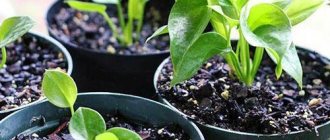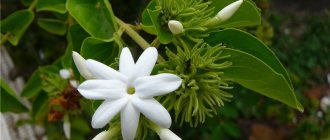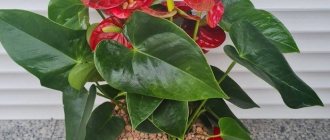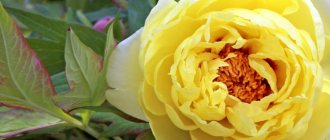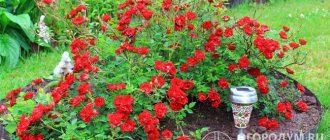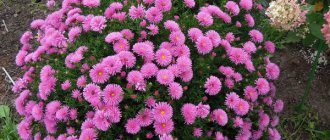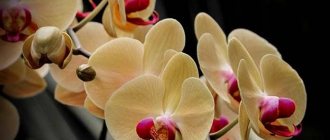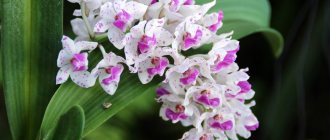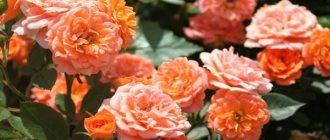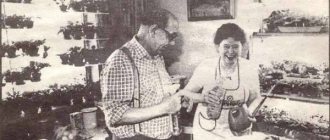Botanical description
Anthurium is popularly called “male happiness” because of beliefs associated with its effect on men’s health. In European countries, the plant is given the name “flamingo flower” because of the red or pink color of the bract, characteristic of many anthuriums, but it is also applied to varieties with white flowers. The Latin name – Anthurium – is derived from the Greek words meaning “flower” and “tail”.
Europeans were introduced to anthurium by the French botanist and landscape architect E.F. Andre. In 1876, he made a scientific expedition to Ecuador, where he discovered a previously unknown plant and sent a copy of it to Europe.
The genus Anthurium belongs to the Araceae family. According to various estimates, it includes from 500 to more than 900 species. Most anthuriums are evergreen herbaceous plants with thick, short stems. The shape and structure of the leaves vary depending on the species. Small square or diamond-shaped flowers are collected in an inflorescence-cob with a leathery bract of various colors - from white to bright red. People far from botany usually mistake a bract for a single petal of a flower . Natural habitat is from Mexico to northern Argentina.
Jolie Pink
Jolie Pink is a product that specializes in growing different varieties of anthuriums.
This variety is distinguished by its compactness - only 40-50 cm in height and has pronounced veins on the heart-shaped leaves. Jolie Pink's "bedspread" is colored pink-lilac, and the bract is notable for its medium-sized tulip-shaped shape (7-9 cm).
The delicate flower Jolie Pink can decorate any interior with its grace. Its undoubted advantages include its resistance to low temperatures. It should also be noted the varieties Jolie Pulse and Jolie Peach, which appeared on sale relatively recently.
Plant varieties and photos with them
In indoor floriculture, the two most common species are Anthurium Andre and Anthurium Scherzer. For both of these the red bract color is more typical, but there are a number of white cultivars.
Due to its large size, Anthurium Andre is most often grown in greenhouses, but is also suitable for home use. Among the most common varieties are white.
White Champion
White Champion. A variety with a yellowish ear on a high peduncle . The snow-white bract is beautifully curved. Over time, a light green tint appears.
White Heart
White Heart. The ear of this variety is bright pink with a more intense color closer to the tip, the bract is white and pointed.
Acropolis (Acropolis)
Acropolis (Acropolis). The spadix is light yellow at the base, with a bright yellow tip reminiscent of a candle flame. The bract is snow-white, the shape is close to round. This variety is characterized by large leaves .
Polaris (North Star)
Polaris (Polar Star). The cob is white, acquiring a pinkish tint over time. The bract - elongated, pointed, with beautiful curves - resembles a ray of a star. As it blooms it turns greenish.
Scherzer
Anthurium Scherzer is more suitable for rooms and offices . A distinctive feature is the cob, slightly twisted in a spiral. Among the white varieties, the most famous is Album with a white cob and a white oval bract. Scherzer anthurium varieties are described here.
What types of flowers are anthuriums?
Indoor flowers and flowering plants with names
Despite the well-established opinion that these flowers are exclusively red, there are a huge number of their color varieties.
White
A special feature of the white variety is its ability to remain fresh for 14 days after cutting; they look great in bouquets.
Otherwise, the description is identical to most other indoor species: the leaves are glossy, large, the inflorescence is a spadix, the only difference is the white bract.
Pastel colors - pink and peach
The pink and peach shades of the flower's cover are very highly valued by flower growers and occupy a worthy place in their collections. Some of them, for example, Tennessee, are distinguished by the fact that as they grow older, the color of both the cobs and the bedspreads changes.
On newly opened flowers, the cover is soft pink, and the spadix is white; when the flower begins to fade, all its parts become light green, merging with the glossy leaves.
Tennessee variety
Reds
Red anthuriums are champions among indoor flowers. This is the most popular and most beloved color, and it is this color that symbolizes that same male happiness. This is what you need to purchase for all the signs to come true.
It is worth noting that it looks quite impressive. With proper care it can bloom almost all year round.
Purple and lilac
Anthurium violet (lilac) is quite rare in Russia. This is an unusually colored flower, which is also called a tulip. This name is due to the similarity of color and small size of the cob. A beautiful, very delicate variety.
Interesting! One flowering lasts up to 3 months.
Anthurium lilac
Ultramarine
The name of the group speaks for itself. These hybrid varieties are characterized by a rather large ear and spathe. Everything is a bright ultramarine color. This color does not exist in nature.
Blue and blue
Blue and blue anthuriums also cannot exist in nature, since the plant itself does not have such a gene. But unscrupulous sellers often wishful thinking. Often these are just white varieties that have been watered with water with the addition of special dyes, that is, they are simply colored.
This is about the same as blue roses. You can buy such flowers solely to make an impression, but they will not take their rightful place in the collection. True blue varieties cannot be purchased in the mass market; these are too rare varieties that have appeared quite recently.
Advice! It's easy to tell if a dye is being used to create a new, unnatural color. To do this you need to look at the leaves. An artificial dye can color everything except the green part of the flower, if the veins are bluish - the flower is a fake, which they are trying to sell at a higher price.
Blue anthurium
Yellow and orange
Orange and yellow anthuriums look original; varieties of these colors stand out from the general background with the color of their cover. Oranges are less bright than reds. Yellow anthuriums have yellow spadix and bracts. An example is Anthurium Orange.
Greens
Florists are happy to use the green colors of anthuriums in their compositions. Against the background of large green flowers with a yellow cob, the rest of the plants look even more impressive.
Green anthurium in a bouquet
Dark - black, chocolate, brown
All varieties belonging to this group are artificially created hybrids that are very popular. Their cover is dark, the shade depends on the variety. The cob is yellow, possibly with a dark tip (for example, Black Prince).
Home care
- Temperature . Like most tropical plants, anthurium is thermophilic. In the summer, it requires a temperature of 20 to 27 °C; in the winter-autumn period it is reduced to 15 °C, but this must be done gradually. The flower does not tolerate drafts. From mid-January, you should start raising the temperature and gradually bring it to summer temperature.
- Watering .
Anthurium, a native of rain forests, loves moisture very much, but does not tolerate stagnant liquid. It would be ideal if there was an aquarium close to the flower. It needs to be watered abundantly, especially in summer. Before watering, you need to make sure that the top layer of soil has had time to dry, but the soil in the pot should not be allowed to dry out completely. Water for irrigation should be at room temperature, you need to let it settle. Lime water should be softened. After watering, the water from the pan must be drained. - Light . Anthurium does not tolerate direct sunlight. It is preferable to place it on eastern and western window sills. If the window faces south, the flower needs to be shaded.
- Soil . Ready-made soil for orchids is perfect for anthurium. The soil should be slightly acidic or neutral. You can prepare the mixture yourself by combining leaf soil and peat in equal proportions. Some gardeners advise mixing the bark with a small amount of sphagnum, peat and charcoal, and also adding some pine needles and brick chips. The soil must be well permeable to air and moisture.
- Trimming. Pruning is necessary if the bush is too bushy or if there are discolored leaves or leaves with white spots. Do not use garden shears that are too large. Secateurs work well.
- Trimming starts from the top. Dried leaves and branches, as well as discolored leaves, are removed. Pruning is done at an angle downwards.
- After pruning until healing, the plant is sprayed with water from a spray bottle.
Feeding .
Liquid fertilizers for flowering plants are used for feeding. The solution should be weak (20% of the dose recommended by the manufacturer). Anthurium should be fertilized no more than once a month, otherwise the leaves will begin to grow without forming buds. Once every 3-4 months you can feed the anthurium with Epsom salt at a concentration of 1-2 tablespoons per 4.5 liters of water. The solution is prepared immediately before watering. At the end of summer, feeding is gradually reduced; in the autumn-winter period, anthurium is not fed.- Pot . The pot must match the size of the earthen ball. In a clay pot, the soil dries out faster; a plastic pot allows you to maintain the required level of substrate moisture. It is desirable that the pot has large drainage holes. A rim-stand along the bottom edge will provide air access to the roots. Under no circumstances should pots be used.
- Transfer. Young plants are replanted annually, then as needed. The main criterion is that the flower becomes cramped in the pot. You should not replant a newly purchased plant - it must get used to the new conditions.
- Before transplanting, a drainage layer (for example, expanded clay) is placed on the bottom of the new pot, and coconut fiber or sphagnum is used as the second layer.
- Next, the main soil is filled in.
- The plant is removed from the pot, the fragile roots are carefully cleared of soil (it is advisable to rinse them under running water), and checked for rot.
- A healthy plant is transplanted into a prepared pot.
- Wintering . Winter for anthurium is a period of rest. During this time, it is kept at a temperature of about 15 ° C, watered no more than once a week and not fed.
Some gardeners also advise laying a layer of sphagnum on the soil surface.
Where to put
— Lighting . Anthurium Andre prefers bright places with diffused light, it should be enough for the full development of the plant, direct sunlight will be harmful, so it will have to be shaded if you have a sunny room. The ideal place would be the western and eastern sides, and if you have a northern side and very little light, then special lamps for lighting plants (regular lamps or phyto lamps) will come to the rescue.
- Temperature . Having chosen a location, the next step is to understand the temperature conditions, drafts should be avoided, and plants should not be placed near heating. Both the first and second are destructive. The ideal temperature range in summer is 20-25 degrees, in winter not lower than 15 degrees, a minimum temperature of 12 degrees is allowed only during plant dormancy.
- Humidity . The plant is tropical - accordingly, the humidity must be appropriate; at home, you can increase the humidity by spraying the plant, you can put the pot in a container with expanded clay and water, this will give additional humidity, use air humidifiers.
Reproduction
Anthurium is propagated by dividing the bush, seeds, shoots and cuttings.
If dividing the bush is used, then when transplanting the flower is divided into several small bushes, which are planted in separate pots.- Seed propagation is more labor-intensive. The seeds are removed from the ripened fruits and the remaining pulp is removed. Having disinfected the seeds in a solution of potassium permanganate, they are laid out on the surface of leaf or peat soil. Germination requires a temperature of at least 22-24 °C. Seeds germinate in 8-15 days. After 1.5 months, in the true leaf phase, picking is done.
- For propagation, you can also use apical cuttings that are rooted in damp sand.
- Side shoots with aerial roots are planted directly into the pot.
Variegated species
The leaves of this group have intricate patterns of veins of various colors.
Peduncles do not look attractive. Therefore, these flower varieties are used for landscaping interiors and summer gardens.
It is distinguished by very large olive-colored leaves. The leaves are decorated with silver veins, their petioles are tetrahedral. In the potted version it is a low-growing species, but in greenhouse conditions it reaches large sizes. Caring for it is more difficult, since it is more susceptible to tick attacks than others.
Quite a large variety. The leaves are velvety, elongated, heart-shaped, bronze-purple in young specimens, with age they acquire a dark green color with clearly defined silvery veins, the petioles are rounded. Cast with a crystal shine. The pattern of veins on the sides originally follows the shape of the leaves. The cob is inconspicuous, emits a clove aroma.
Anthurium Clarinervium (clear-veined)
Anthurium is not very tall. Has a short stem. The leaves are velvety, with light green veins clearly visible against a dark green background. The inflorescence is unattractive, but with a pronounced pleasant aroma.
Diseases and pests
Anthurium is susceptible:
- Fungal diseases such as anthracnose, septoria, as well as parasites - mealybugs, thrips, aphids. To destroy them, special fungicides and insecticides are used.
- Also, at low temperatures and a lack of microelements, the leaves may curl and wrinkle.
Among the variety of species and varieties of anthuriums, it is difficult to choose the right plant for yourself. To make the choice easier, we have prepared materials for information about Anthurium Black, including Black Queen (Black Prince), Dakota, Cavalli, Hooker, Utah, as well as pink and crystal.
Black
The luxurious anthurium variety Black Queen is a popular large-sized hybrid. On the surface of a dense, glossy black bract with a burgundy tint, all the veins stand out in relief, which creates a particularly impressive flower.
Thanks to the light green color of the cob, the color of the bedspread appears even darker.
The foliage part of the plant consists of large leaf blades of a dull green hue with light veins.
You can take a closer look at the Black Queen anthurium in the video:
Similar plants
- Calla, or calla lily, also belongs to the Araceae family. Unlike anthurium, whitewing tolerates northern climates well. In Russia, it can often be found in swamps, in ditches with standing water. The inflorescence in appearance and structure resembles an anthurium; its bract is always white.
- Zantedeschia is a close relative of the whitewing, previously included in the same genus with it. Comes from Africa.
- Callopsis, another plant from the Araceae family. A characteristic feature is a short cob.
- Anaphyllum also belongs to the Araceae family. Originates from the tropical forests of South India. The structure of the inflorescence is close to anthurium, but the bract is purple in color and spiral-shaped.
- Spathiphyllum, another member of the Araceae family, closely resembles anthurium. Its spadix is larger, the bract is always white, and turns green over time. Originally from Central and South America, it is also found in Oceania. Like anthurium, it is used in indoor floriculture.
Anthurium with surprisingly graceful white flowers is an excellent choice for a gardener . The contrasting combination of several varieties looks especially impressive. If you place it next to red or orange, they will perfectly complement and highlight each other’s advantages.
Anthurium andreanum
Thanks to its spectacular flowering, this type of anthurium can be called the most famous in the world. Since the 70s of the last century, when plants of this particular variety of anthurium ended up in the hands of its discoverer, Anthurium Andrianum has taken one of the first places among potted crops and among plants intended for landscaping gardens, as well as those grown for cutting.
Today, flower growers are offered a lot of Andre anthurium varieties and unique hybrids, striking the imagination with a variety of shapes, colors and sizes of inflorescences. The homeland of the species is the forested mountainous regions of Colombia, where Andre's anthuriums grow at an altitude of approximately 2.5 km above sea level. Look at the garden tradescantia photo!
This plant, from 50 to 150 cm in height, leads the life of an epiphyte, for which its entire structure is adapted. Anthurium has a short, succulent stem, on which long petioles of ovoid, pointed leaves are tightly attached. The leaf blades are leathery and dense. The average leaf length is from 20 to 40 cm, and its width is almost half as much.
On this topic:
BACK
FORWARD
1 of 8
Like other epiphytes, Andre's anthurium acquires many aerial auxiliary roots on the stem, which help the plant receive nutrition and moisture from the atmospheric air. The species, according to the description of anthurium, is characterized by long flowering. Moreover, what many habitually consider to be an anthurium flower is its inflorescence, consisting of a spathe or bract and a spadix, which unites many small flowers.
The bedspread can be heart-shaped or oval, its fabric, as in the photo of the brown anthurium, is leathery, with noticeable veins. On average, the bract can reach a length of 15–20 cm. Its width is somewhat narrower. As the flowers mature, the bract folds back, fully revealing the light cream or yellow spadix.
It was thanks to the bright cover that the red anthurium was once noticed among the riot of tropical colors. But today, in addition to varieties that delight gardeners with scarlet bracts, plants with a wide variety of colors of both cobs and spathes are not uncommon. You can see white, pink and even black anthuriums. There are varieties and hybrids with fancy colors that combine several bright shades at once.
After pollination of the flowers, red or orange berries are formed on the inflorescence, each containing a pair of seeds. True, since modern gardeners are increasingly growing not varietal, but hybrid anthuriums, seed propagation of the crop is giving way to vegetative methods. And on industrial plantations, tissue culture is used to obtain mass seedlings.
This approach allows us to create and offer to lovers of exotic plants varieties of anthurium that are never found in nature. Such an example would be the anthurium shown in the photo with two bracts or complex interspecific hybrids with an unusual veil shape, miniature or, conversely, very large inflorescences.
Possible difficulties
The purchased flower is immediately freed from the store-bought substrate, since it requires special watering and is not suitable for the home area. The most common disease is rotting of the roots and stem parts due to excess moisture and low temperature . Anthracosis - drying out of leaf blades. Fungicides will help fight the disease. A small amount of calcium causes the ends of the leaves to turn black. The leaf part curls in dry air and insufficient light.
To avoid possible difficulties and withering of the plant, you must adhere to the rules of care . Only an integrated approach will help you enjoy lush flowering and colorful views.
>
- Author: Maria Sukhorukikh
Rate this article:
- 5
- 4
- 3
- 2
- 1
(0 votes, average: 0 out of 5)
Share with your friends!
How to transplant
The main requirement when transplanting anthurium is to be careful and accurate. In addition to the fact that we are dealing with a poisonous plant, we need to be especially careful with its fragile and brittle roots.
The pot is selected slightly larger than the previous one. Otherwise, the strength and energy of the flower will be wasted on root growth, and it will not be enough for abundant flowering. As for the shape, it is better to choose pots that are equal in width and depth. This type of dish prevents water stagnation, which is extremely important for the anthurium plant. It also has plenty of space for drainage.
Need for transplant
Young anthuriums need to be replanted every spring. When the flower reaches three years of age, its root system will develop much more slowly. From now on, it is enough to move it to a new pot every 2-3 years.
Soil for anthurium
The optimal soil composition for the active development of anthurium should include 4 components: leaf soil, peat, coniferous soil, sand. It is enough to take one measure of sand, and the remaining components - in double quantities.
Lay out the bottom layer of drainage, lightly sprinkle it with an earthen mixture, and place the root part of the anthurium in the pot. Then soil is gradually added and watered in layers to shrink it. Do not compact the soil to prevent damage to the roots. You can only press lightly.
